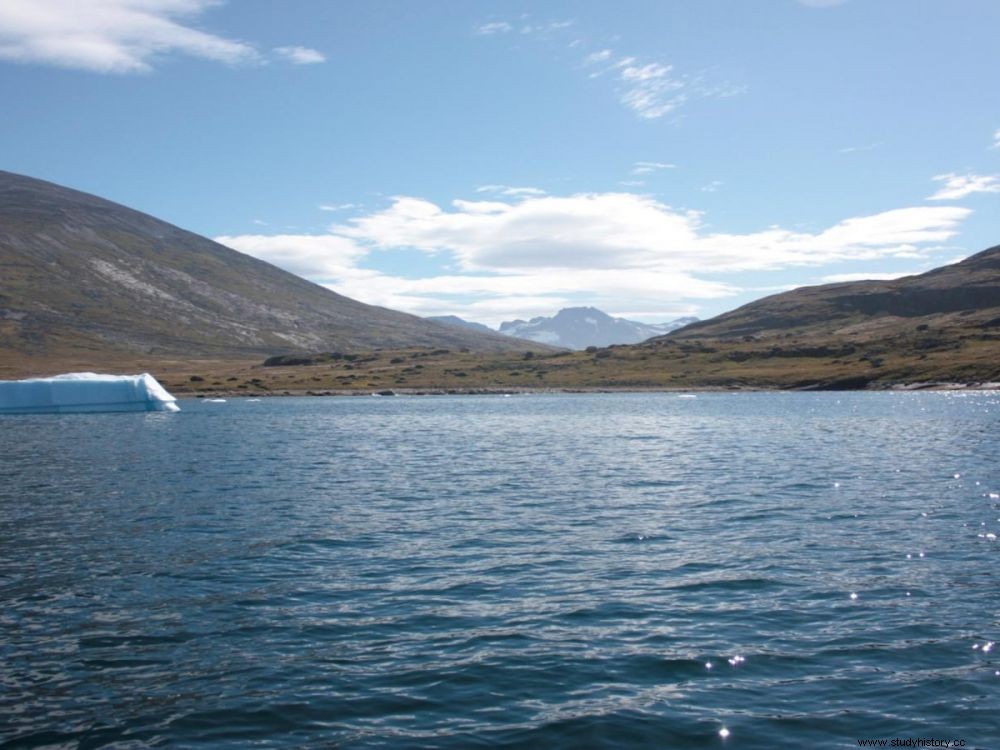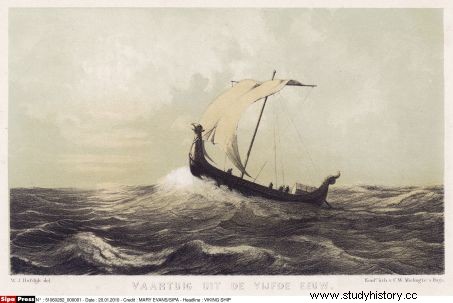Archaeological excavations shed new light on the fate of the Vikings who, around the year 1000, settled in Greenland before disappearing five centuries later.

Landscape of southern Greenland, where Viking colonies were established around the year 1000.
A scientific article published on August 8, 2018 in the journal Proceedings of the Royal Society B looks back at the work carried out on walrus ivory in order to understand why the Vikings of Greenland disappeared. An exciting story that Sciences et Avenir told you in 2016. To rediscover in the article below.
In 986 AD, a certain Eric the Red scooted over the stormy waters of the Dark Ocean. The red-bearded man managed to convince a few hundred Icelanders - men, women and children - to embark with their cattle on a handful of knorrs, solid boats, to reach this land he explored further west and evoked by the Scandinavian sagas. A country covered with pastures… The Green Land (Greenland). After several days of difficult navigation, the first coasts arise from a thick fog. Ships with prows sculpted with frightening sea monsters then glide slowly over the black waters of the fjords freed from their ice. And reality suddenly appears in all its rawness:an inhospitable coastline and valley sides covered with a thin carpet of arctic heather. The colonists only have to rely on Odin, Thor or even a certain Jesus, founder of a new religion to which many of them have just converted... On this new land they will however reach to settle. Before disappearing in an enigmatic way, barely five centuries later.

Early Viking ships ventured on the high seas. The knorr were clinker-sided cargo ships (©Mary Evans /Sipa).
Were they wiped out by the Inuits who landed on this second largest island in the world in the 13th century? Has adaptation to the rigors of the climate been a failure? Were they victims of poor soils? Epidemics? The results obtained by a team of archaeologists from the North Atlantic Biocultural Organization (NABO) who have been working in Greenland for several years, shed new light on this question of the brutal eclipse of the Vikings from Greenland, the one of the great enigmas of Scandinavian archaeology.
Walrus ivory, the keystone of the economy
They have indeed revealed in the journal Science the data obtained on the diets of these first settlers, or even on the evolution of the landscapes, in particular thanks to the excavations carried out on the site of Tasilikulooq , an old Viking farmhouse. For Jette Arneborg of the National Museum of Denmark, Copenhagen, joined by Sciences et Avenir , the Vikings would have successfully established themselves in Greenland, their living conditions being ultimately quite close to those of their continental compatriots. "Despite a difficult start, these Scandinavians settled down, building dairies, churches, etc." she explains. A first colony chose the south of the island while a second settled 400 km to the north, near Nuuk, the current capital. There were so many constructions at the time that today there are more than four hundred ruins... At its peak, the population of Kalaallit Nunaat (the Inuit name of Greenland) had between 3,000 and 5,000 souls (against 55,000 today). But the new scenarios established by the NABO refine this vision, suggesting that the Vikings would have focused less on breeding and pastoralism than previously thought, favoring trade. Some would have bartered with the Scandinavian homeland, exchanging polar bear or arctic fox furs or narwhal tusks for what they lacked:grain - summer being too short to grow wheat, timber - island has virtually no trees, iron and tools. But above all, they would have taken advantage of the high value of walrus ivory, a highly sought-after product in medieval Europe, to make it the keystone of their economy. “The Scandinavians had found in the North Atlantic a marine ecosystem teeming with walruses, which they were able to exploit for ivory as much as food “says Jette Arneborg. Enough to ensure substantial income. The study conducted by NABO on the diet of these first settlers also reveals that it has changed significantly during their 450 years of presence. Isotopic analyzes (carbons 12 and 13) carried out on the collagen of the bones of several human skeletons found on the island, thus showed that when the Vikings of Greenland began to disappear at the end of the 14th century, the products of of marine origin constituted up to 80% of their nutritional intake.
Climate change in question
“But from the XIII e century, the economy and the climate began to change “, explains Jette Arneborg. Ice cores have revealed that between 1343 and 1362, the average temperature in Greenland dropped dramatically. Life then became difficult. With the cold, the glaciers began to invade the land, draining tons of sand and gravel. Pasture areas have decreased. Overexploited, the soils have become sterile. “As the ice advanced, fishing also became more risky with seals and walruses having to be fished further and further out to sea ". On the other hand, around 1400 the value of walrus ivory fell. In Europe, we prefer that coming from Russia and especially from Africa… And it was probably several years without harvest, without fodder and without economic outlets for local raw materials that finally got the better of the Scandinavian settlers. “Archaeology reveals dwindling populations over time , explains Jette Arneborg. The settlers had to abandon the big island as they went along, and make their way back to Iceland or to the mainland ". Ironically, while archaeological excavations are still continuing, climate change is now threatening the precious remains. Until then well preserved in the permafrost, the organic remains of this Viking presence are now victims of global warming and for some are rotting even before archaeologists have had time to recover them.
